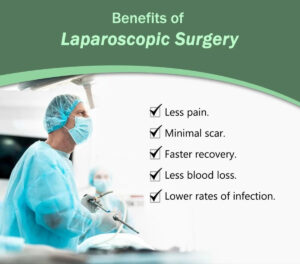Laparoscopy is a kind of procedure that requires smaller cuts than one would imagine. In this Article, You will learn the Procedure, Treatment & Even Consult with our Best Laparoscopic Surgeon.
The name derives from the laparoscope, which is a small tool that comes with tiny video cameras and an LED on its end. When surgeons insert it through a tiny cut in the body, they are able to see a video screen and observe what’s happening inside your body. Without the instruments, they’d need to create a bigger opening. Because of special tools, surgeons won’t be able to access the body. This also means that there will be less cutting.
Have you heard of people talking of “minimally invasive” surgery? The laparoscopic procedure is among them. It was initially used by doctors to perform gallbladder surgeries and gynecology surgeries. Then, it was used for the intestinal tract, liver as well as other organs.
Why there is a need for Laparoscopic surgeons?
Laparoscopy is commonly utilized to pinpoint and determine the root of pelvic or abdominal discomfort. It’s typically performed in cases where noninvasive methods are not able to aid in diagnosis.
In many instances, abdominal problems can be detected using imaging techniques, such as:
- ultrasound is a method of using high-frequency sound waves to produce pictures of the body
- CT scan This is a set of X-rays that capture cross-sectional views of the human body
- An MRI scan that makes use of radio waves and magnets to create images of the human body
Laparoscopy is a procedure that is used in cases where these tests do not provide sufficient information or information to make a definitive diagnosis. It could also be used to collect an incision, or sample of tissue, taken from an organ within the abdomen.
Your doctor might suggest an exam through laparoscopy that will examine the following organs:
- appendix
- gallbladder
- liver
- pancreas
- small intestinal tract and the big intestine (colon)
- Spleen
- stomach
- the pelvic and reproductive organs
When you look at these areas using laparoscopes, your doctor might be able to identify:
- A stomach or abdominal mass or an abdominal tumor
- the liquid within the abdomen cavity
- the liver condition
- the efficacy of certain treatments
- the extent to which a certain the extent to which a particular has advanced
Your doctor might also be able to carry out a treatment for your condition as soon as you are diagnosed.
Benefits

- There are smaller marks.
- You are released from the hospital faster.
- You’ll experience less discomfort as the scars heal and they heal more quickly.
- You can return to normal activities faster.
- There may be smaller scarring on your internal skin.
How it’s done
In the majority of cases, it is done with a general anesthetic. Laparoscopes are a telescope-like tube that is introduced into the abdomen via tiny cuts near the navel or another site. The internal organs are separated from the wall of the cavity by carbon dioxide gas that is then injected through the abdomen cavity. This allows for greater visualization with the laparoscope, while simultaneously reducing the risk of injuries. To manipulate the tissue that is being examined, a small probe is placed through the same incision inside the lower abdomen. To determine if there are any obstructions the fluid flows through the cervix, the uterus, and the fallopian tubes.




